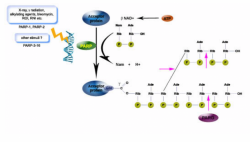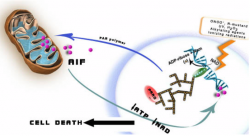PROJECTS

Our Work
Our group works on two overlapping fields: oxidative stress and poly(ADP-ribosyl)ation. Oxidative stress arises from an imbalance between the production of reactive oxygen and nitrogen intermediates (ROI and RNI, respectively) and the antioxidant defense system. Various pathological conditions such as inflammation and ischemia-reperfusion injury, diabetes are accompanied by oxidative stress. One oxidant species, peroxynitrite is of special interest for our group. Peroxynitrite (ONOO-) is formed in the near-diffusion limited reaction of nitric oxide and superoxide. Peroxynitrite nitrates and oxidizes proteins, initiates lipid peroxidation and causes DNA breakage. The DNA breaking effect of peroxynitrite has led us to poly(ADP-ribosyl)ation (PARylation).
PARylation is a posttranslational protein modification carried out by PAR polymerase (PARP) enzymes. The best known member of the PARP family is a DNA nick sensor enzyme that becomes activated by DNA breaks. Activated PARP cleaves NAD into nicotinamide and ADP-ribose and covalently attaches a PAR polymer to itself and other suitable acceptors such as histones. Via PARylation or protein-protein interactions PARP regulates among others chromatin organization, DNA repair, transcription and replication. Excessive DNA damage can also trigger a PARP-mediated necrotic cell death pathway. The peroxynitrite-PARP activation pathway is an important target in stroke, myocardial ischemia-reperfusion injury, inflammations, shock, diabetes and related complications. PARP inhibitors may also be used as adjuvant chemotherapeutic agents in cancer.